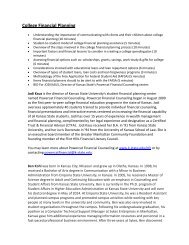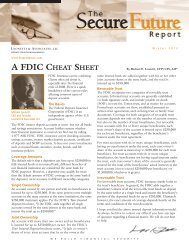INFORMED FOR LIFE - Advisor Products
INFORMED FOR LIFE - Advisor Products
INFORMED FOR LIFE - Advisor Products
Create successful ePaper yourself
Turn your PDF publications into a flip-book with our unique Google optimized e-Paper software.
INVESTMENT<br />
The Importance of Reviewing Your Portfolio<br />
There are many lessons to be learned from the<br />
2008-2009 financial crises. For individual investors,<br />
the most important lessons come out of a complex<br />
theory of investing called Modern Portfolio Theory.<br />
In its most basic form, this theory stresses the<br />
importance of diversifying your portfolio among<br />
different asset classes for safety. As the old saying<br />
counsels, “Don’t put all your eggs in one basket.”<br />
Unfortunately, diversification was proved not to be<br />
as effective as believed and the baskets failed<br />
many investors when they needed them to protect<br />
the eggs the most.<br />
Does this mean that we should abandon the theory<br />
of diversification? Absolutely not! Diversification has<br />
been useful over the long term. But investors may<br />
need to find another way to protect portfolios from<br />
the short term shocks. Investors need to recognize<br />
the value of diversification and, at the same time,<br />
compensate for its weaknesses. However, diversification<br />
is still an important first step in the investment<br />
process.<br />
So how can investors overcome the shortcomings<br />
of diversification and protect their portfolios from<br />
major downturns of the market? Large institutions<br />
such as pension plans and insurance companies have been employing downside protection strategies in their<br />
own portfolios for years. These are tools that attempt to bring more certainty to the investment process and<br />
can help stabilize a portfolio during market volatility. While the relationship between stocks, bonds, real estate,<br />
and alternative investments can change dramatically over time, there are other investments that have an<br />
opposite relationship to stocks. By allocating a portion of your portfolio to these tools that historically move<br />
opposite to stocks, you can help ensure that something within your portfolio is always working toward your<br />
goals. Unfortunately, many of these tools have not been easily accessible for the individual investor, until<br />
now. Employed correctly, these tools are designed to reduce risk compared to a portfolio not implementing<br />
any form of downside protection strategy. This results in a portfolio with much less volatility and downside<br />
risk, but one that keeps most of the upside participation intact.<br />
To many investors, the math of portfolio returns is not as simple as it seems on the surface. If your portfolio<br />
declines by 20%, you need more than 20% to recapture all your losses. Actually you would need a 25% return<br />
to get back to the breakeven point. If your portfolio declines by 40%, you need a return of 67% to get back to<br />
4<br />
www.rpgplan.com<br />
Continued on page 5






